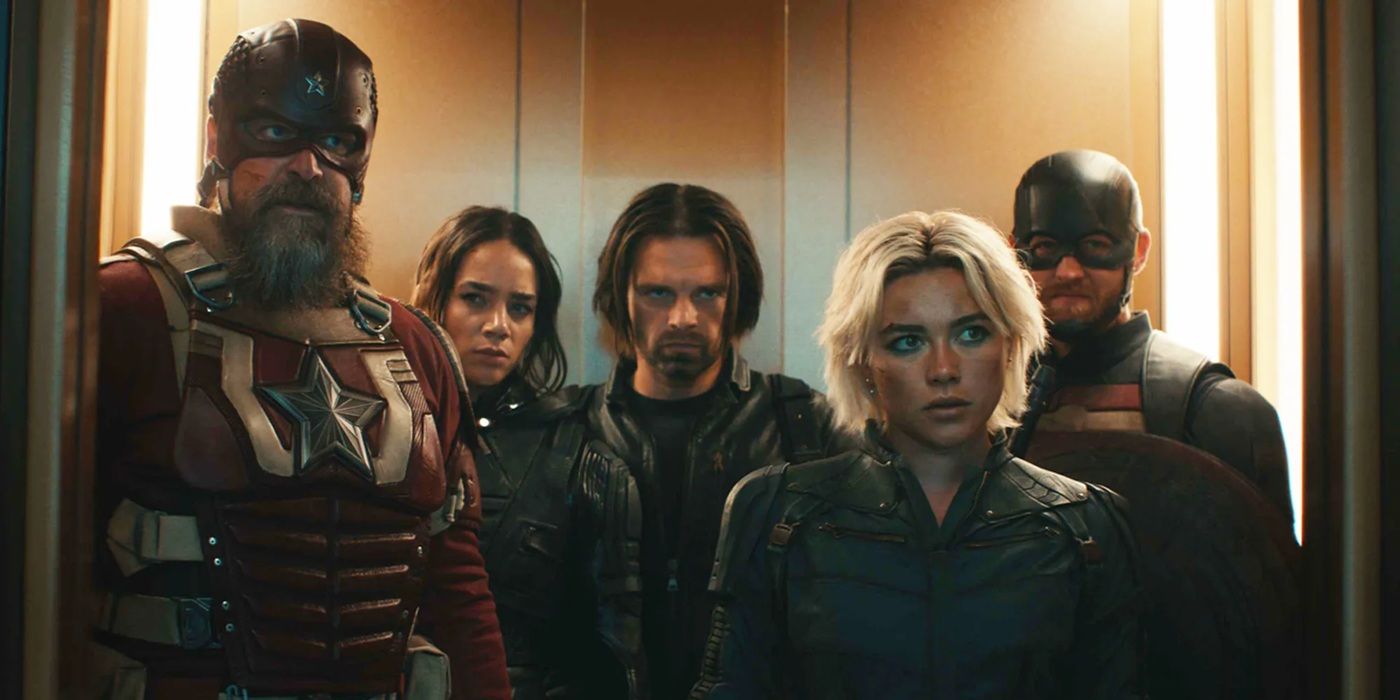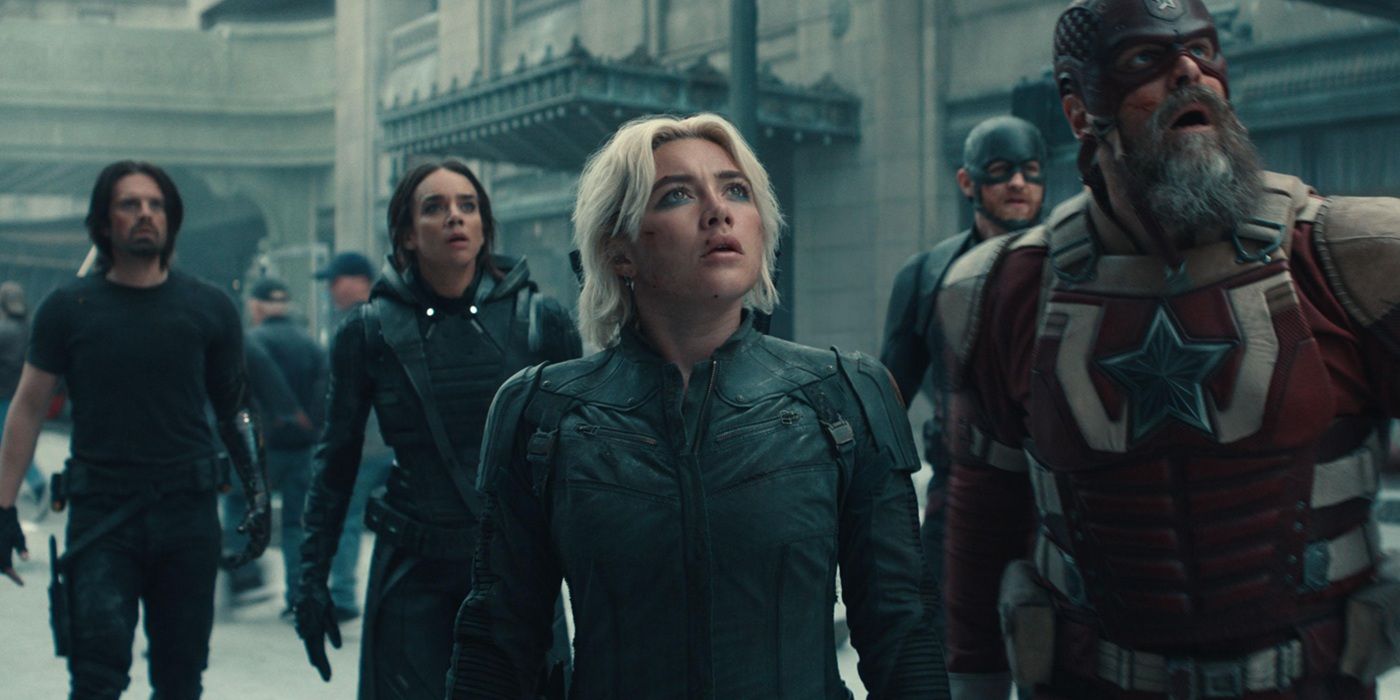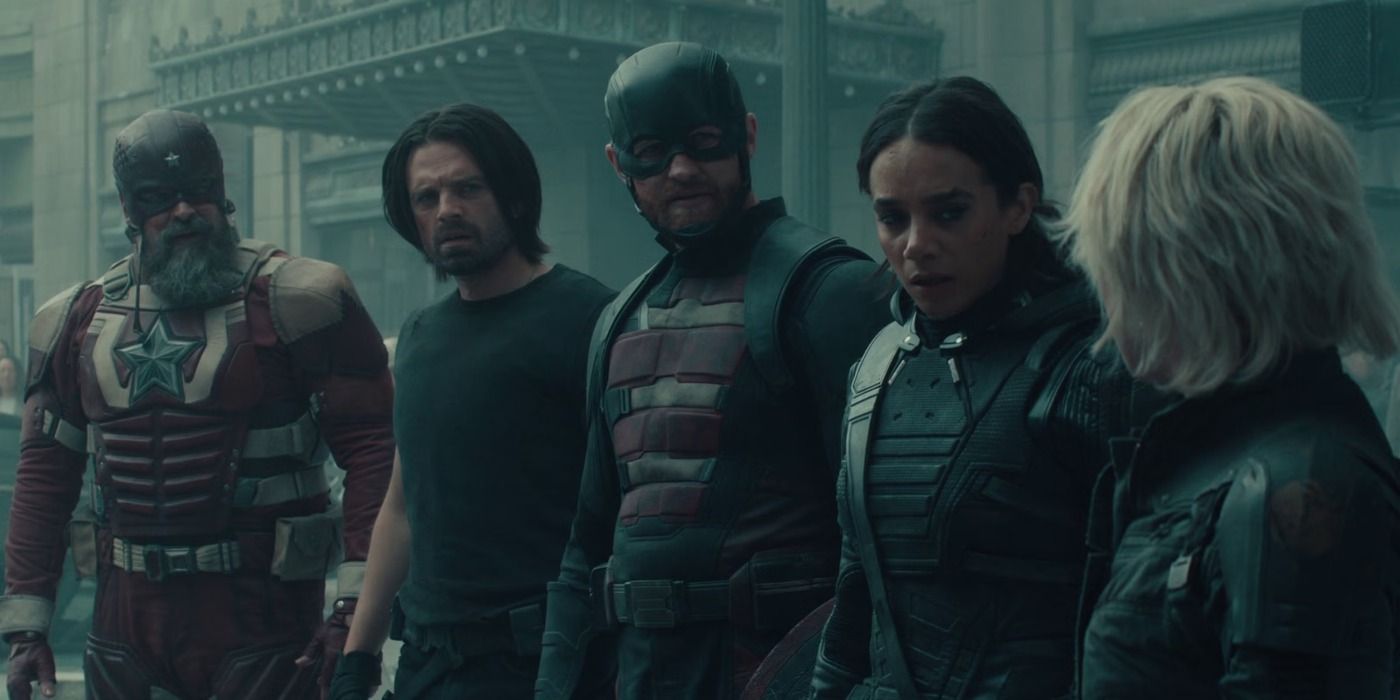
I can’t help but feel elated as Thunderbolts has been wholeheartedly welcomed, garnering praise from both critics and fans. What truly sets this film apart is its climactic revelation – the marketing may have spoiled it prematurely, but it’s safe to say that the twist about The Thunderbolts transforming into The New Avengers has been a game-changer. Marvel even unveiled a new poster for Thunderbolts, with each character’s silhouette mirroring an Avenger’s – now that’s exciting!
Though the members of the Thunderbolts/New Avengers may not immediately strike you as typical Avengers, they are equally deserving of bearing the team’s name. Marvel’s choice to assemble lesser-known characters from other MCU productions and present them as a team aligns more with how the Avengers were depicted in comics for years. These characters might not be household names like Captain America, Iron Man, Thor, or The Hulk, but they have certainly demonstrated their worthiness to be called The New Avengers.
The Avengers Were Not Always Marvel’s Big Team

Typically, fans view The Avengers as Marvel’s equivalent to DC’s Justice League, gathering their top heroes onto one squad. Originating from the comics by uniting various Marvel characters, the Avengers team often served as a base for characters who couldn’t sustain their own comic series for much of its run. While Captain America, Iron Man, and Thor usually formed the core trio, the team largely consisted of characters that resembled a collection of misfit toys, such as Hawkeye, Captain Marvel (Carol Danvers), Vision, Scarlet Witch, Ant-Man, Wasp, and Wonder Man. Interestingly, the fact that each of these characters now has their own Disney+ series or films demonstrates the power of the Marvel brand. So, it’s possible we could see Jack of Hearts and Hercules join the team in the future, right?
Since the 1980s, it was primarily The X-Men and The Fantastic Four who held significant weight among Marvel’s teams, with Spider-Man being their top hero. This was the reason behind selling off their film rights, as they were considered the most valuable. However, starting in the 2000s, with comic series such as The Ultimates and The New Avengers, Marvel began to emphasize The Avengers as a more significant element within their universe. This shift wasn’t accidental, considering it was around this time that Marvel Studios was established and they started focusing on characters related to the Avengers.
The New Avengers team opted to incorporate Wolverine and Spider-Man into their ranks, stating that they were home to Marvel’s top-tier champions. When the Marvel Cinematic Universe (MCU) debuted, it was based on the strategy of transforming characters once deemed B-list heroes into A-listers, a strategy that proved successful. Characters such as Iron Man, Thor, Captain America, Black Widow, Hawkeye, and Hulk have never been more popular than they are now.
In a fresh rephrasing, it could be stated as: “The introduction of characters from series such as ‘Black Widow’, ‘The Falcon and the Winter Soldier’, and ‘Ant-Man and the Wasp’ in the Thunderbolts seems reminiscent of how Marvel Comics have been for quite some time. With Sam Wilson now holding the Captain America shield, it appears Marvel is uncertain about Bucky Barnes’ role. Therefore, placing him on a team resembling The Avengers could be an intriguing solution.
Despite varying responses towards Black Widow, Marvel found a notable character in Florence Pugh’s Yelena Belova and decided to place her in a role reminiscent of Natasha Romanoff, within an Avengers-like setting. Characters such as John Walker, Red Guardian, and Ghost had unfinished narratives, with no conventional sequel planned. To address this challenge, Marvel combined these characters into a team, mirroring a common comic book solution. While each character might not be capable of spearheading a project individually, they collectively form a more substantial entity.
The Thunderbolts Thematically Match the Overarching Theme of the MCU

Starting with the debut of “Iron Man” in 2008, characters within the Marvel Cinematic Universe have been shaped by complex individuals who undergo transformations into admirable superheroes. For instance, Tony Stark, initially a wealthy and self-centered weapons manufacturer, evolved into Iron Man. Similarly, Thor was a spoiled prince before being humbled and regaining his divine status. Previously an arrogant doctor, Doctor Strange mastered the Mystic Arts. Characters like Ant-Man and several Guardians of the Galaxy members initially led criminal lives but found redemption as heroes. This narrative underscores that there’s always room for self-improvement and becoming a better person, no matter one’s past.
In the Marvel Cinematic Universe (MCU), many characters aren’t initially portrayed as struggling with significant character flaws, like Captain America (Steve Rogers) and Captain Marvel (Carol Danvers). However, a defining characteristic of the MCU is the theme of transforming villains into heroes, where they find redemption and purpose through heroic deeds. This is why the Thunderbolts, being a team of reformed antagonists, align well with the overall narrative of the franchise.
*Note: The Thunderbolts are a fictional superhero team in Marvel Comics, initially composed of villains disguised as heroes. Their inclusion in the MCU is speculative and not yet confirmed by Marvel Studios.
In the Marvel Cinematic Universe (MCU), the Thunderbolts or New Avengers are a team of characters who carry heavy burdens from their pasts, shaped by the pain they’ve experienced and the harm they’ve caused others. One of the most disturbing instances was John Walker’s actions in The Falcon and the Winter Soldier, where he took an innocent life – a scene that remains one of the darkest and most chilling in MCU history.
Ghost, known as a villain in both the MCU and comic books, has never shown heroic qualities. Similarly to Black Widow, Yelena also bears a burden of blood on her ledger. Bucky Barnes’ past as the Winter Soldier made him an unsuitable candidate for the idealistic Captain America that Sam Wilson ultimately became, a better fit to carry the shield.
The Thunderbolts represent the heroes that the audience needs at this moment – they reflect our current times, much like how The Avengers did in 2012.
It’s quite suitable that they decided to rename them The New Avengers, given the changes they made to the team. While it’s true that The New Avengers introduced characters like Wolverine and Spider-Man in the comics, they also incorporated several street-level heroes such as Luke Cage, Spider-Woman, Echo (who was disguised as Ronin), and a lesser-known character named The Sentry.
With iconic figures such as Captain America and Iron Man taking charge, the team had some unconventional members: Wolverine with his lethal prowess, Luke Cage who carries a questionable past due to wrongful conviction, Spider-Woman serving as a double agent, and The Sentry, an omnipotent figure with a dual personality. This wasn’t the typical image associated with “Earth’s Mightiest Heroes,” much like the Thunderbolts*. They may not fit the traditional Avengers mold, but in a peculiar twist of events, they make for an exceptional new team of Avengers.
Do The Thunderbolts* Have a Better Dynamic?

As a dedicated movie enthusiast, I must acknowledge that the Avengers franchise, particularly its climactic chapters in “Avengers: Infinity War” and “Avengers: Endgame,” stand tall among Marvel’s most impressive feats. The characters who make up this extraordinary team have undeniably etched their names into the annals of cinematic history (their grand final bows in “Endgame” were truly fitting).
However, it’s worth noting that the team wasn’t without its peculiarities. One such instance is that, despite being part of the same squad for four films, Thor and Black Widow never shared a dialogue scene together. They appeared in scenes alongside each other, but their paths failed to cross verbally until “Thor: Ragnarok.” It was this film that finally delved into Thor’s relationship with Bruce Banner, as the Avengers movies predominantly portrayed Thor and the Hulk as sparring partners.
It’s not quite right to evaluate the Thunderbolts solely on the basis of a single movie, given that characters such as Ghost and The Winter Soldier have less screen time compared to Yelena, John Walker, and Red Guardian. These characters appear to possess potential for growth. Ghost serves as a prime example, despite her limited involvement with the main group, there is a clear depiction of her sentiments towards John Walker, Yelena, Red Guardian, and Bob. Here’s hoping that Avengers: Doomsday offers them some substantial interplay.
In their well-defined team structure, the Thunderbolts find themselves advantageously poised for Avengers: Doomsday, appearing to be the natural successors to the original Avengers. Audiences have developed an affinity for this group of outcasts and understand how they operate as a unit. However, it remains uncertain which Avengers team Sam Wilson will lead, though potential members may include Ant-Man, Shuri, and Shang-Chi. The opposing Avengers dynamic is yet to be fully established before the impending epic clash with The Fantastic Four and X-Men.
Read More
- Who Is Harley Wallace? The Heartbreaking Truth Behind Bring Her Back’s Dedication
- 50 Ankle Break & Score Sound ID Codes for Basketball Zero
- Here’s Why Your Nintendo Switch 2 Display Looks So Blurry
- 50 Goal Sound ID Codes for Blue Lock Rivals
- 100 Most-Watched TV Series of 2024-25 Across Streaming, Broadcast and Cable: ‘Squid Game’ Leads This Season’s Rankers
- Elden Ring Nightreign Enhanced Boss Arrives in Surprise Update
- How to play Delta Force Black Hawk Down campaign solo. Single player Explained
- Jeremy Allen White Could Break 6-Year Oscars Streak With Bruce Springsteen Role
- MrBeast removes controversial AI thumbnail tool after wave of backlash
- Mirren Star Legends Tier List [Global Release] (May 2025)
2025-05-15 03:03